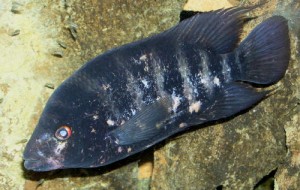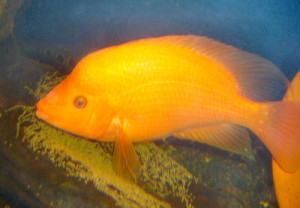Color polymorphisms are an interesting phenomenon especially when considered in the field of sensory ecology. A polymorphism is when two or more related traits appear within a single mating population, and in many cases this is seen as individuals expressing different body colors. For individuals in a given population, it is fascinating to consider the benefits and disadvantages each trait poses and the pressures that influence the prevalence of each genetic morph.
A particular species of neotropical fish native to the great lakes of Nicaragua, Ampholophus labiatus, also known as the red devil cichlid, expresses a polymorphism where 90% of the individuals are genetically dark colored and 10% are predisposed to be a gold color. Despite their reduced prevalence, the gold morphs have some adaptively significant beneficial traits like a faster growth rate and a larger body size, leading to higher dominance levels and a greater sexual appeal to females. In this species and many others that have color polymorphisms, body color is able to dynamically change based on the given environment. Researchers were interested in studying the camouflaging ability of the two color morphs of red devil cichlids to learn how it may affect predation levels, and to better understand the genetic distribution within the population.

Dark morph cichlid (www.cichlidforums.com)

Gold morph cichlid (animal-world.com)
What were their hypotheses?
Research has shown that darker individuals are able to alter their color shade to blend in with certain backgrounds, but little research has been done directly comparing background matching ability between dark and gold individuals. The researchers expected that, due to their greater genetic prevalence within the population, dark individuals would be better at changing their body color to blend in with their environment, leading to reduced predation rates. They also predicted that gold individuals would not posses the same ability to successfully camouflage with their background.
What did they learn?
During the study, the researchers observed the color changing ability of dark, gold, and mottled (mixed color) individuals from the same population when placed in tanks with either light or dark backgrounds. They found that the genetically dark individuals were consistently able to alter their body shade to match either light or dark backgrounds. This result supported their hypothesis and also was consistent with past research performed on dark morph individuals. Though their color matching was not perfect, it did show a compromise strategy that would allow the dark individuals to quickly match a range of different background colors while swimming through a more mixed colored environment.
Contrary to the dark individuals, the genetically gold and mottled red devil fish did not show a successful ability to adjust their body color to match the background. In fact, they surprisingly showed the opposite tendency of brightening their color against dark backgrounds and dimming it against light ones. This result supports the researchers’ hypothesis and suggests that though lighter colored individuals are able to change their body color, it is not used to become less conspicuous.
Why does it matter?
The results from this study shed light on the question of why gold morph individuals are far less prevalent than their dark counterparts in their native lakes. Though the gold individuals posses some beneficial fitness traits of size, dominance, and a sexy bright color, the tradeoff with a far more conspicuous body color and the inability to camouflage ultimately greatly reduces their reproductive success. It is imperative to study color polymorphisms because they hold a lot of ecological significance and are extremely important when it comes to genetic variation in populations. Body color provides an extremely important visual signal to mates and predators, so it is critical for us to be aware why major differences within a given population’s coloration may exist. The red devil cichlid provides a fascinating example of a species whose color morph is very relevant to the individuals’ ability to thrive in different environments.
To learn more about this study, you can take a look at the following article:


